2024 Senior Trip Diary Part 2
continued from Senior Trip Diary Part I
March 18
Up with the chickens (polli in Italian) to hit the airport in Athens for our flight to Rome (Roma). It’s a big day, and we’re excited and a little tired from our last night in Greece. We have a bit of time in the airport after a breezy check in — although we all had to check our carry-on bags at the desk. Some students fan out for a last Greek meal or a souvenir or freddo cappuccino. The Athens airport is a little old school, so we hop a bus that drives out to our waiting airplane and we climb aboard using the stairs. The flight is relatively brief, but long enough that they serve a light snack, which was some type of vegetable spread between two small pieces of bread that the seniors despised.
We all landed in Roma except for two formerly “carry-on” bags. Unfortunately, Jack Landes’ and Tori Hill’s bags took an extended Greek vacation. While Jack and Tori pondered how to make the clothes on their backs last four days, we all stumbled on the bus and headed for the Eternal City of Roma. Rome is said to have been founded in the 8th century BC by brothers Romulus and Remus, who were mythically raised by wolves and established the city among the seven hills. In an argument over the city, Romulus killed his brother and named the place after himself. Otherwise, we would be visiting Remo, which doesn’t have quite the same ring to it. These are things one ponders as we wait in line at our first stop, a gelato place right off of our first Roman square, the Piazza Navona. The piazza is teeming with life, both Italian and seemingly everywhere on earth. Strolling through the piazza you can hear dozens of languages. Here we are also reminded to watch out for our belongings as pickpockets target the unsuspecting tourists like lionesses target the weakest buffalo on the plains Serengeti. And Jack and Tori already had little left to lose (too soon?).
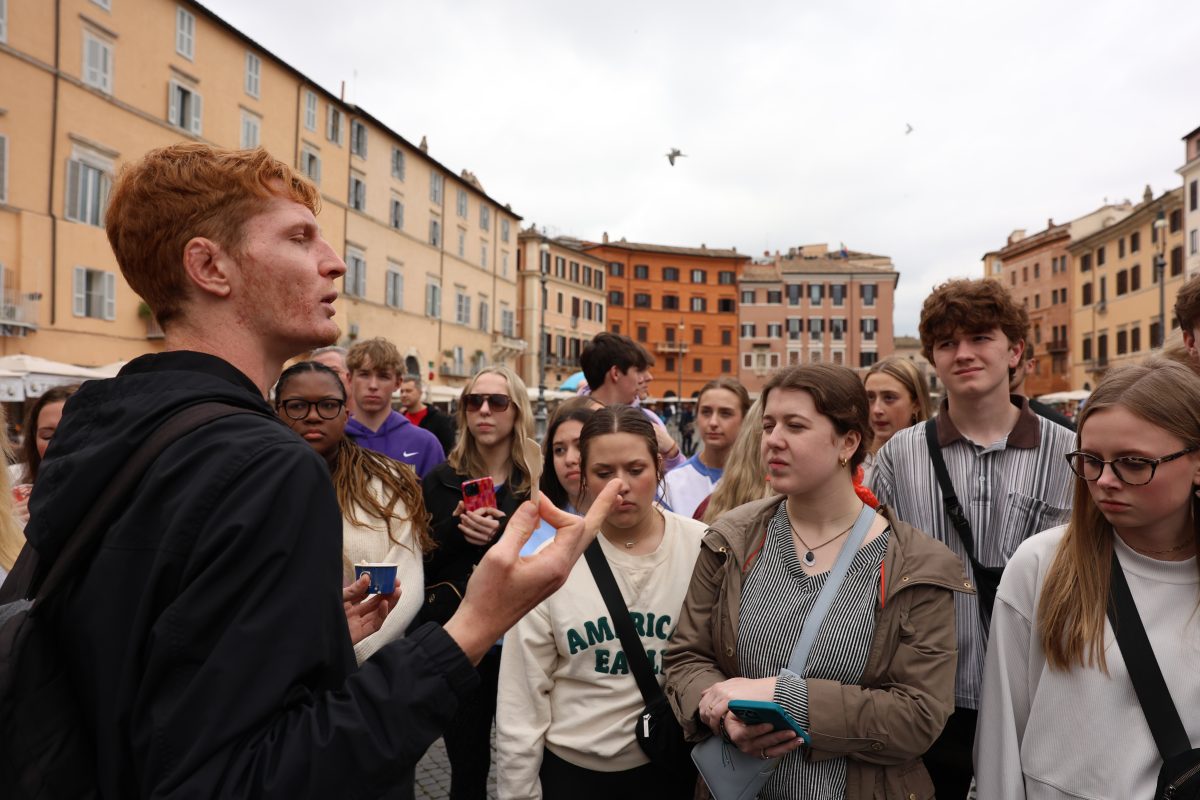

Niccolo led us down the back alleys of Rome until we reached the Jewish ghetto, which is said to be some of the most sought-after real estate in the Eternal City. It is also said to have some of the best cuisine. Niccolo pointed out a few of the quick, popular tourist eateries for the students to grab some pasta or pizza. We chaperones asked for a more traditional experience. He pointed us to a restaurant off the beaten path, a small eatery known for its traditional Roman pastas that was popular with the locals. Two of the pastas on my list were Roman originals that I had eaten versions of in the States: cacio e pepe and pasta carbonara. This place seemed to specialize in the former, which is an Italian version (sort of) of macaroni and cheese. The Romans prefer their pasta al dente, so, when in Rome… it was molto bene! For starters, Sully introduced us all a true Roman-Jewish original: Carciofi alla Giuda. It is a fried artichoke that sort of serves as a Roman chips and salsa. The artichoke is trimmed and fried at a low heat to cook it and then a high heat to make the leaves crispy. It comes out looking like you burned your artichoke. I’ll admit I was a bit hesitant to try it as I assumed it would taste just like burned leaves, but the experience was incredible. You pick a leaf off the artichoke and pop it in your mouth. The initial sensation is the crispy crunch, but once the crunch is gone, you’re left with a buttery, flavorful taste that lingers on your tongue. I can’t really think of anything else like it here in the States.


After reconvening following lunch, our group learned more about the Jewish ghetto, or Jewish Quarter, which was established in the 16th century as an attempt by the Catholic leadership to sequester the rising Jewish population of the city after their expulsion from Spain. As we traveled down one narrow alley in the ghetto, we could see hundreds of brass squares that had been laid into the cobblestone in front of apartment doors. These are called stumbling stones (stolpersteine) and they serve as a reminder of the thousands of Roman Jews who were removed from their homes and murdered in concentration camps. It was a sobering reminder of the depth of suffering that has taken place throughout the history of this ancient place.
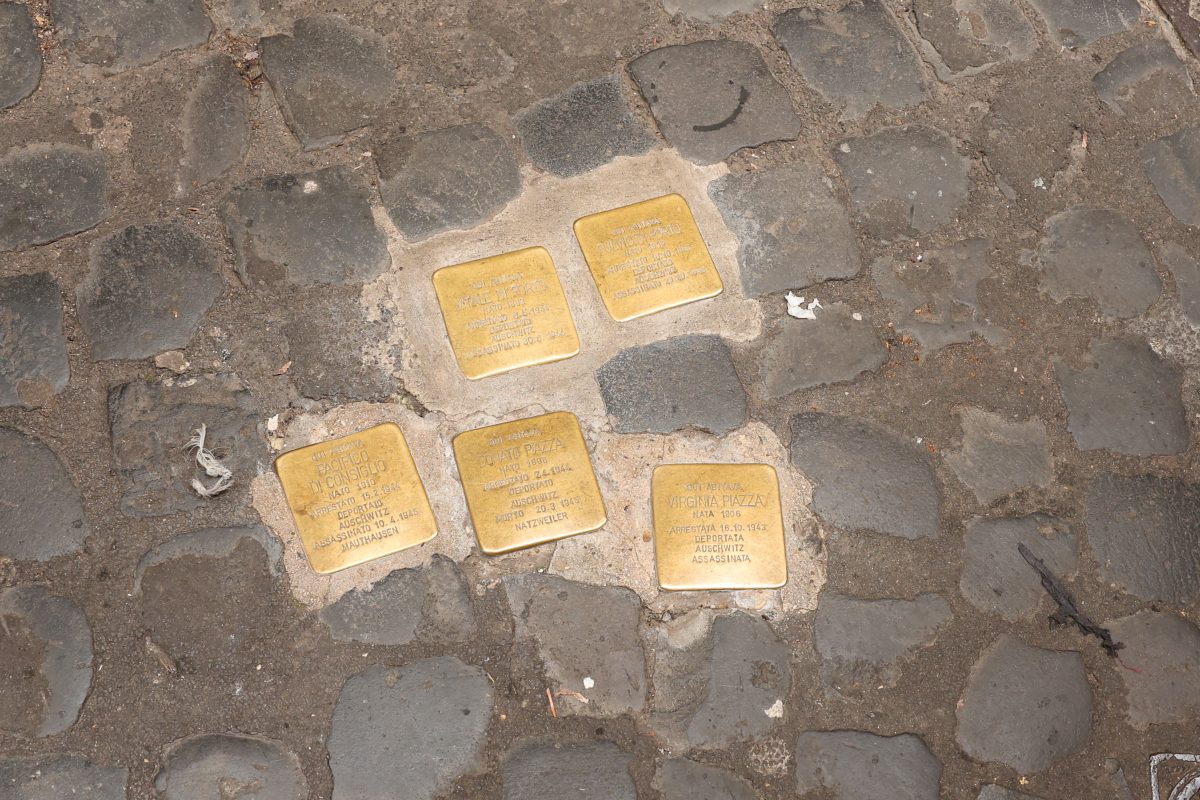
We returned to the bus to venture outside of the Roman walls to the Appian Way to reach the entrance to one of the most famous ancient catacombs: Catacombs of Callixtus. When we arrived at the entrance to the catacombs, we were asked not to take pictures inside among the tombs. Our first step inside the catacombs was a long stairwell that led straight down to one of the lowest levels of the catacombs. The air cooled as we settled a couple hundred feet below ground level. We learned the history of the catacombs from our guide, who told us that these catacombs were often used to house the bodies of Christian martyrs, including many who died during games in the Colosseum. The catacombs once also included the bodies of 16 popes. After Christianity was made the official religion of Rome in the 4th century, Christians moved the bodies and bones from the catacombs to local churches. Before that time, foreign invaders would often break into the catacombs to loot the bodies for treasures that did not exist. It was not the last stark reminder of the changing fortunes of Christians in Rome that we would have on our trip.
Our final visit on the very busy day was a trip to St. Paul’s Basilica Outside the Walls, which is one of only four major papal basilicas in Rome. As its name suggests, this massive church stands just outside the ancient walls (the Aurelian Walls) of Rome. It cuts a magnificent figure, even in this city of ever-present manmade beauty. The Basilica was founded by Constantine I on the assumed site of the burial place of the Apostle Paul.
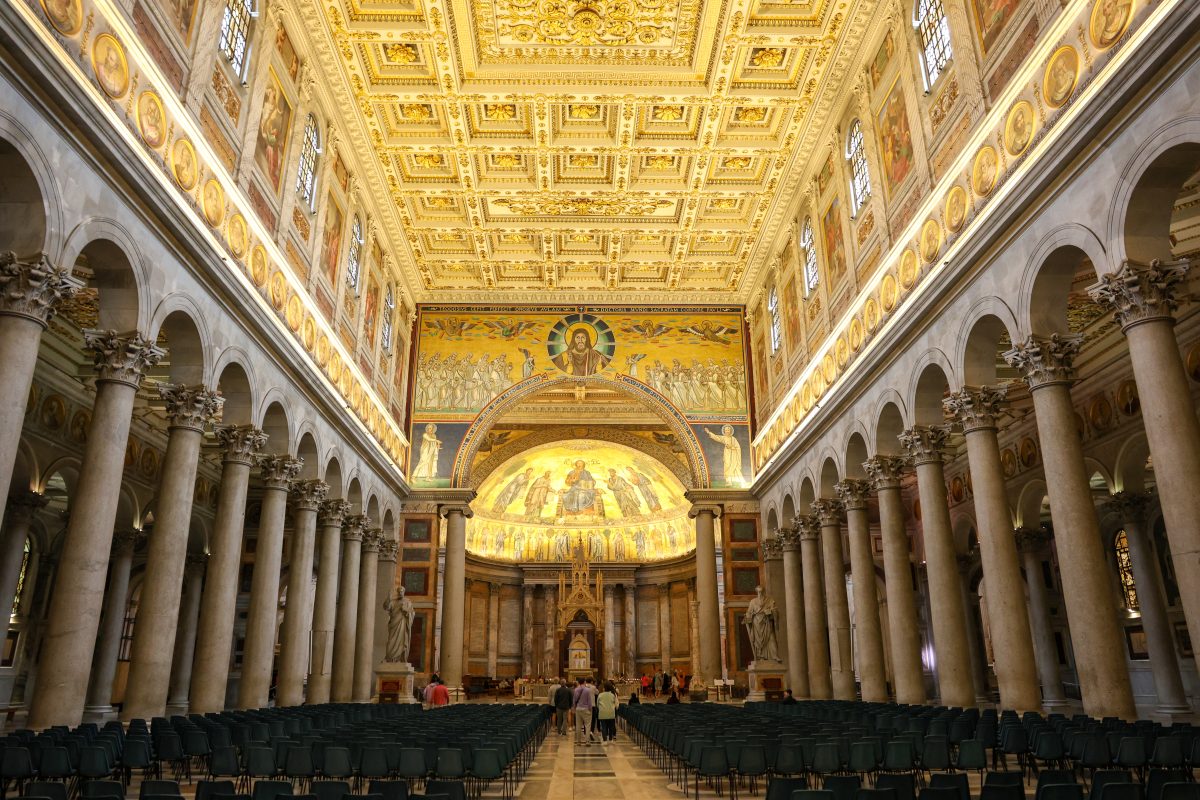
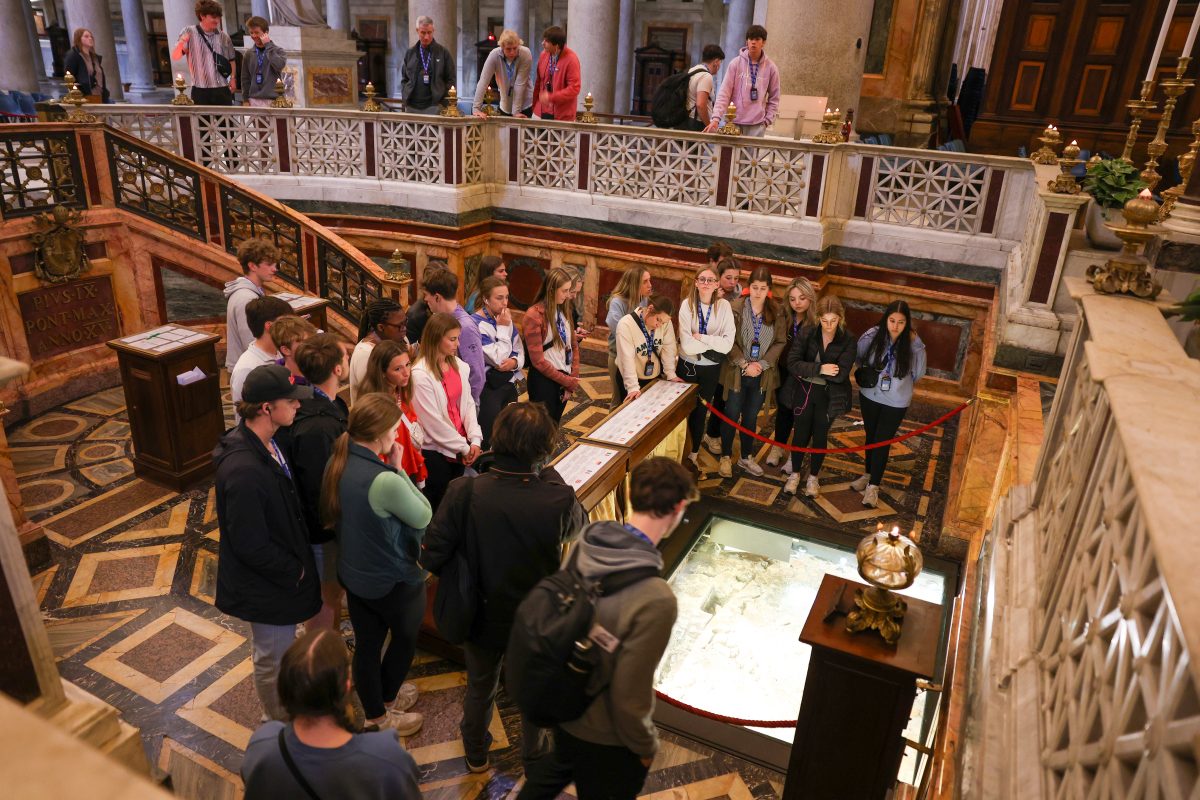
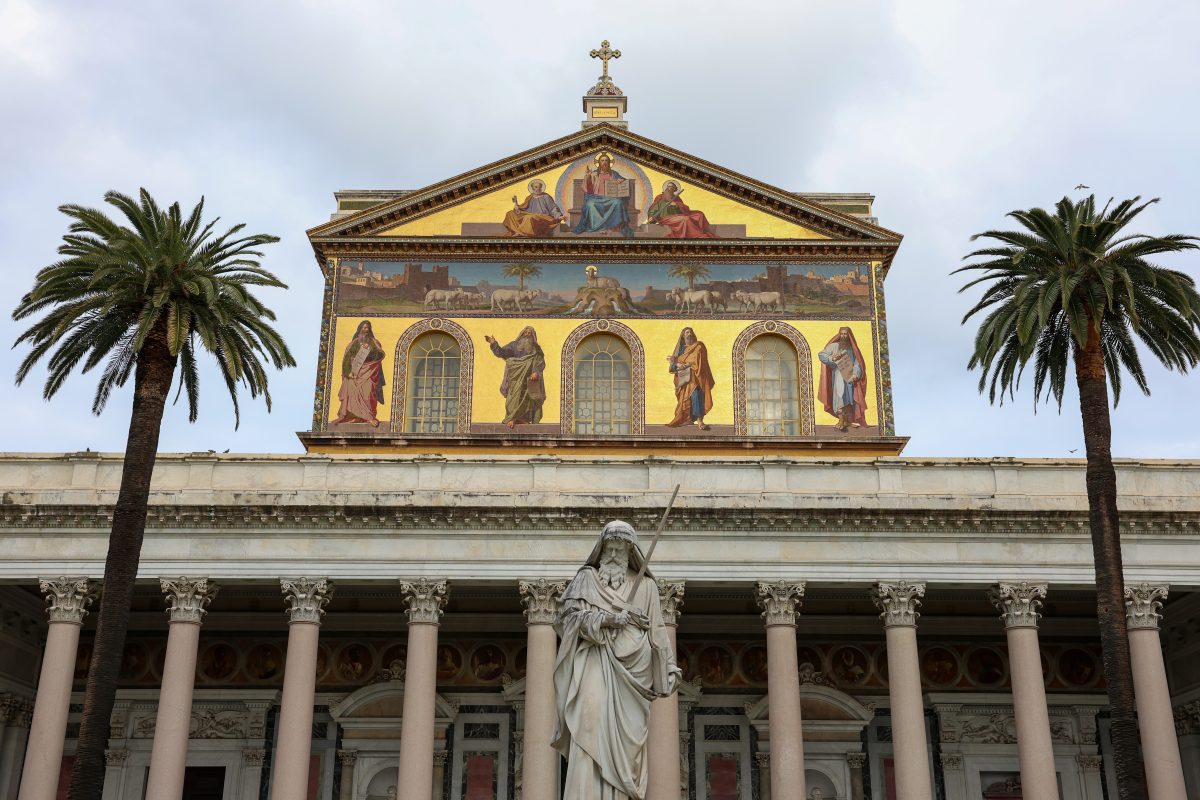
Following our departure from the Basilica, we made for our hotel, which would be our accommodations for the remainder of our stay in Europe. It seemed our hotel had recently become a hotel, in fact, we may have been its first clients. Before its new identity, the hotel is said to have been a convalescent home of sorts. Fortunately, we just needed a place to sleep and shower, and it served for both (for most of us).
March 19
Today is Pompeii Day! We woke up to our first Italian breakfast (deli meats and cheeses, bagged pastry, coffee) and then set out for a three-hour drive to the legendary city of Pompeii. It was a beautiful morning for travel as we headed south through verdant Italian hills. As we neared Pompeii, Mt. Vesuvius, or what is left of it, loomed in the distance. To our right we saw the Gulf of Naples and shoreline of the city of Napoli (Naples) embracing the Mediterranean in a warm hug. In the distance was the famous Isle of Capri and, hidden from our view, the Amalfi Coast just beyond the shore’s bend.
Pompeii has become a major tourist destination since its rediscovery and proper excavation began in the 19th century. Today was no different as we walked up to the entrance to the destroyed city, which was buried and largely forgotten after the catastrophic eruption of neighboring Vesuvius in 79 AD. Before the disaster it had been a bustling Roman city. Oddly enough, thanks to this disaster, it lives again and provides visitors with an incredibly well preserved look at life in a Roman town only 40 years after the death and resurrection of Christ.
Pompeii is a massive, active excavation site. Due to the nature of our trip, we only had time to tour a small portion of the city. Unfortunately, this meant I would miss the part of Pompeii I had most been looking forward to: Seeing the Amphitheatre of Pompeii, where Pink Floyd played an absolute banger of a live set back in 1972. However, we did get to see most of the highlights normal people would want to go to Pompeii to see.
The entrance to the UNESCO World Heritage Site is located at the end of a beautiful walk. In both Rome and Pompeii I marveled at the uniqueness of the Umbrella Trees (Pinus Pinea) that rise dozens of feet above the streets, with their boughs hanging over much of the city and creating an umbrella-like effect. These same trees created a beautiful canopy for our walk into Pompeii. As we step onto the cobblestone streets, we are immediately transported back into ancient Rome. Many of the houses and shops that once lined the street remain nearly fully intact. In the aforementioned streets you can see and literally touch the grooves made for chariot wheels to pass through. One of our first stops in the city are the ancient baths which are in remarkably preserved condition. One of the wealthy families in the city had a portico built with a mosaic warning trespassers about the vicious dog that lived there with a picture of said dog and the words “Cave Canem” accompanying the picture. It’s a famous picture I remember from my world history book from high school. Speaking of famous pictures, if there is one thing people want to know about when you return from a trip to Pompeii, it is the preserved bodies of people who were mummified by the ash or pyroclastic flow. Now, we did see some of these famous “bodies” on display near the Pompeii forum, but we were told that these were actually casts made by filling the hollowed out shapes of people whose final positions had been covered over with heaps of ash. Inside, the organic material had long since decomposed. The casts helped them live again and speak to us from beyond the graves. So, no, we did not see the bodies, but we saw the casts and it was enough to get a feeling for the horrible realization that came too late for these ancient Romans: That they were about to die.
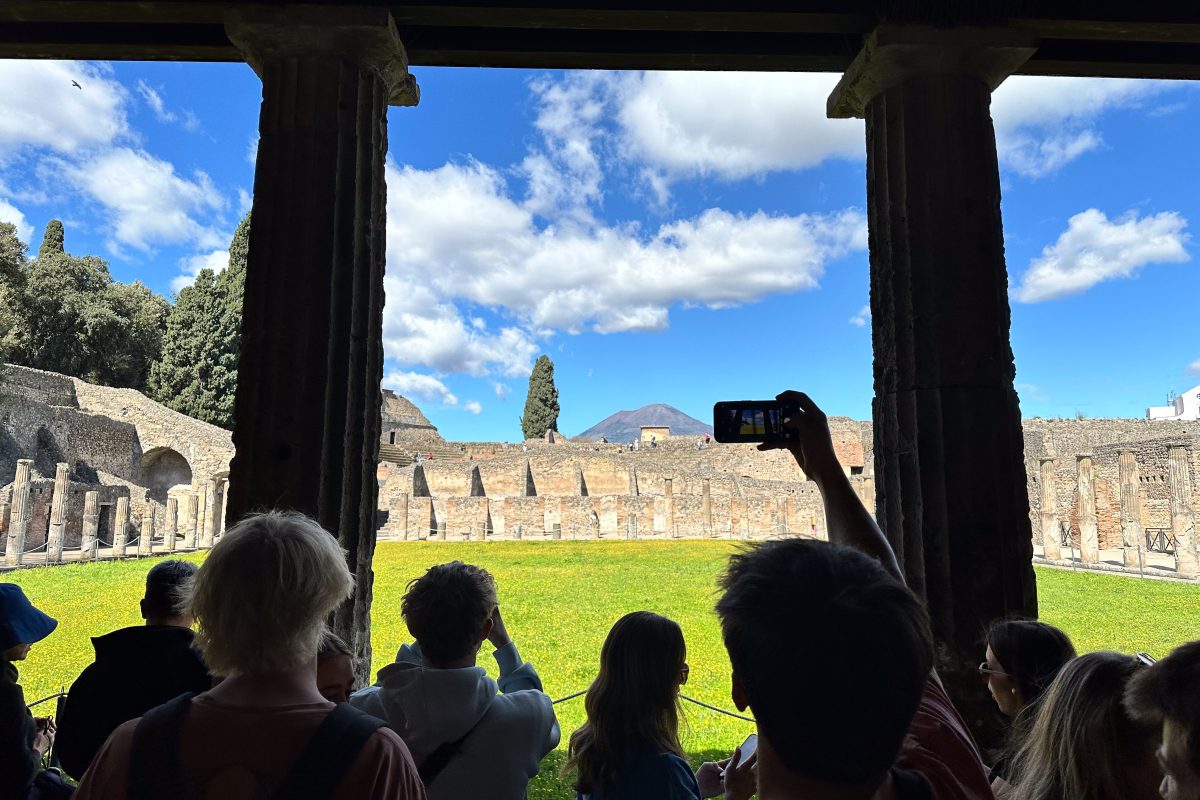
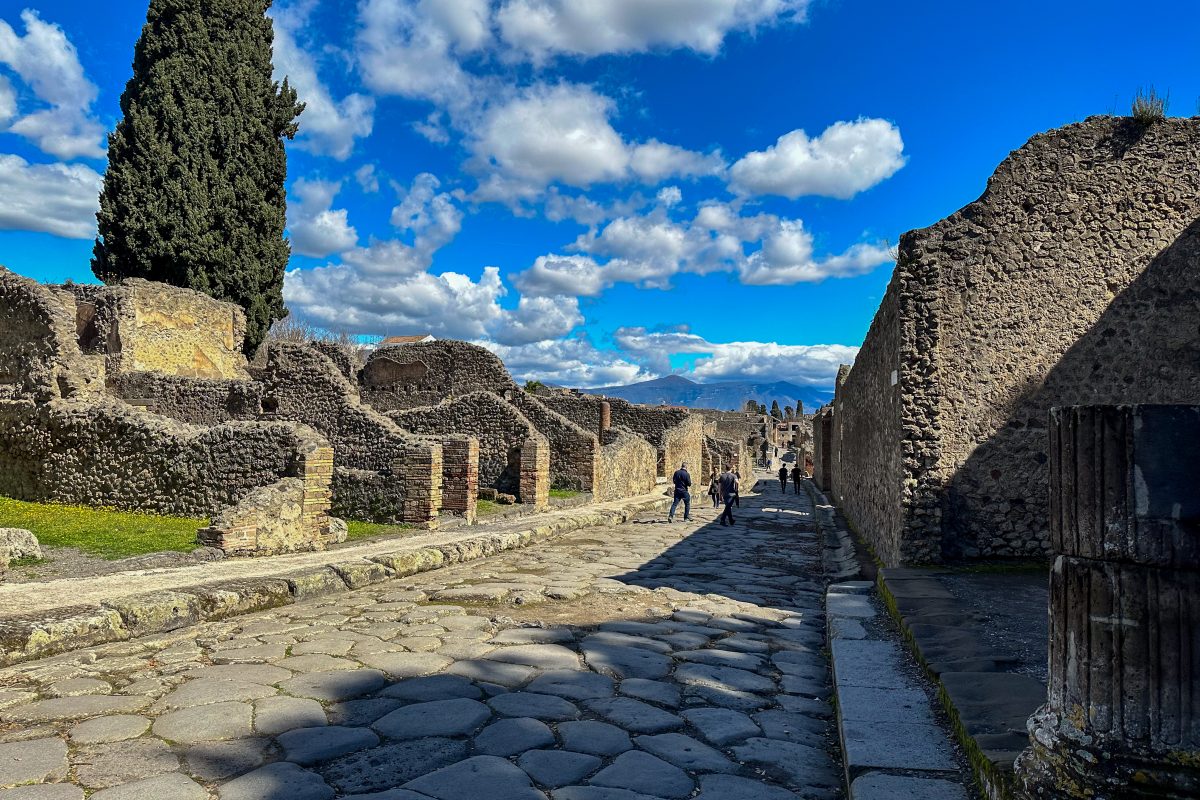
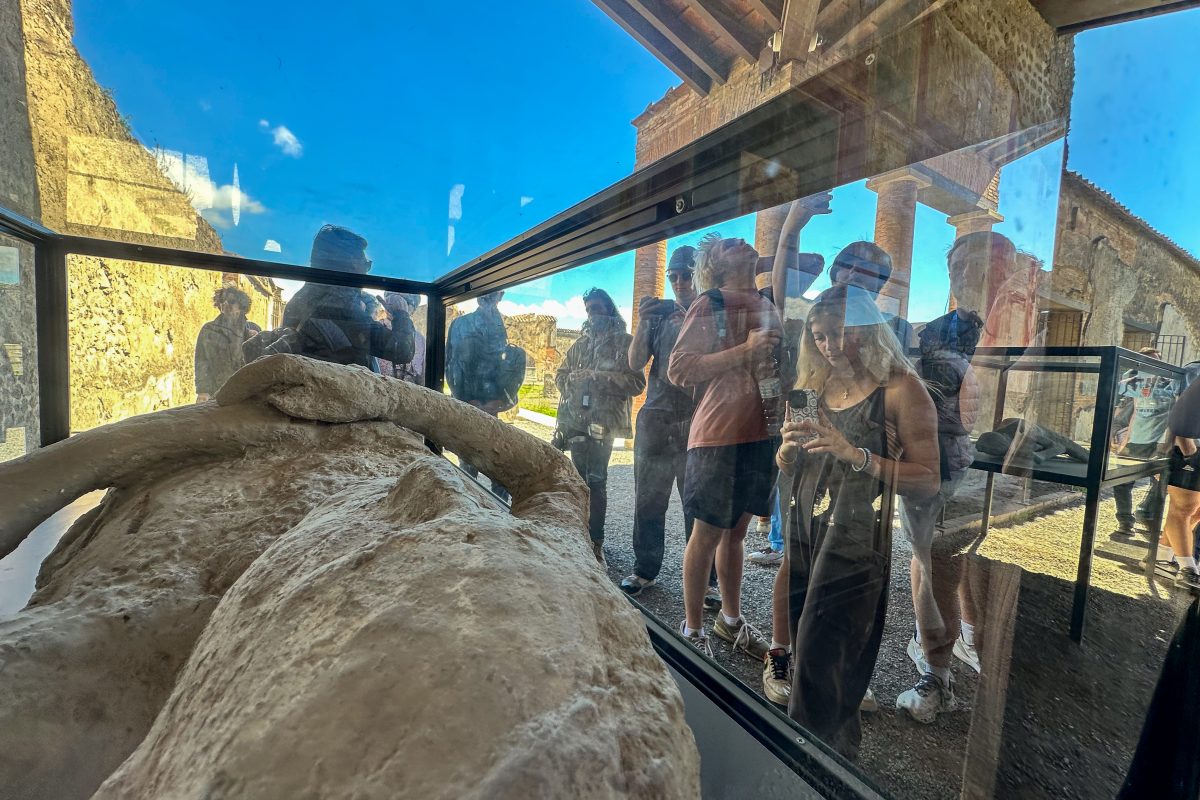
My favorite part of the Pompeii was the forum, which offered incredible open views of the city with Mt. Vesuvius, cratered from its explosion almost 2,000 years ago, looming in the background. In all, I’m not sure if a day would have been long enough at Pompeii, as there is so much to see and they are constantly discovering more.
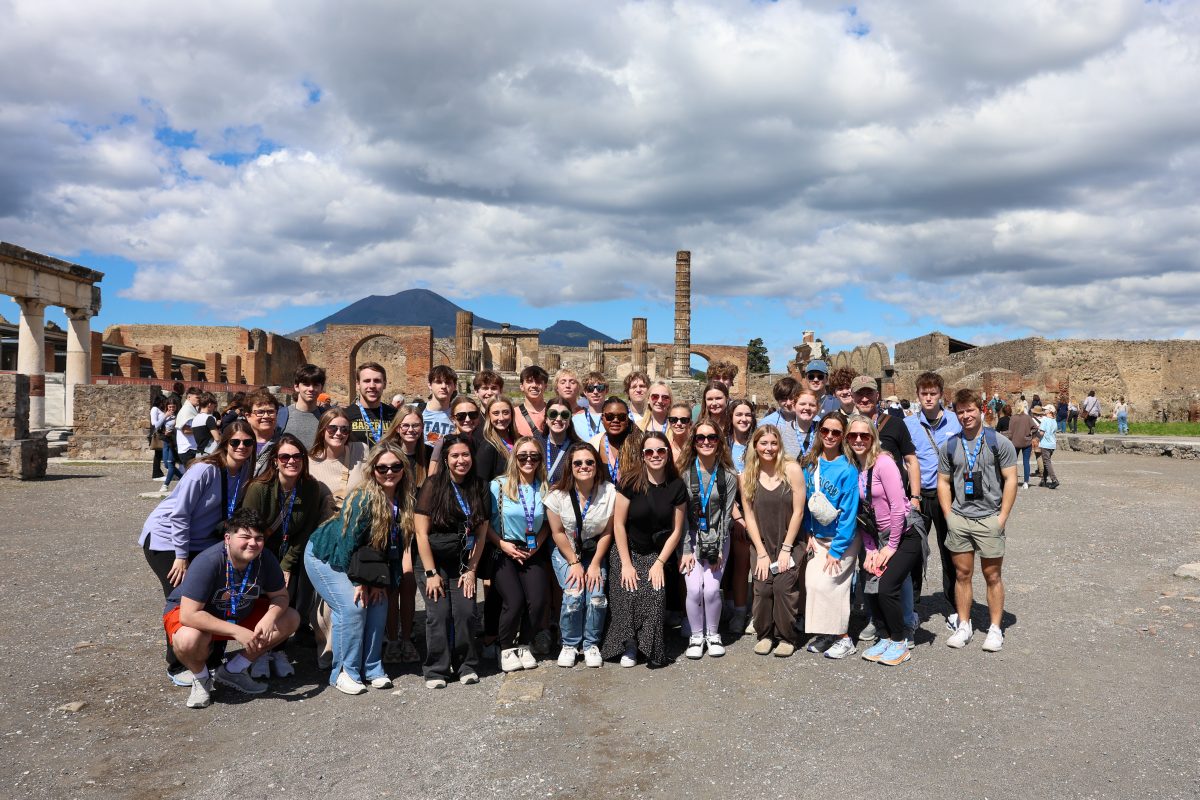
After a brief spell in the city to scrounge for souvenirs, we headed up Mt. Vesuvius for a group lunch at a pizza place with what our guide told us were incredible views. Our bus driver handled the many switchbacks up the mountain like a pro, and we arrived for our meal. The mountain top restaurant looked down on the Gulf of Naples and the city itself. It was an incredible sight. At the restaurant, we enjoyed incredible Napoli-style pizza. It was thin crust with a delicious char, fresh basil and mozzarella. While the site was a tourist destination, it was some of the best pizza I’ve ever had. After about 100 pictures overlooking Napoli, we headed back down the mountain and back north for Rome.
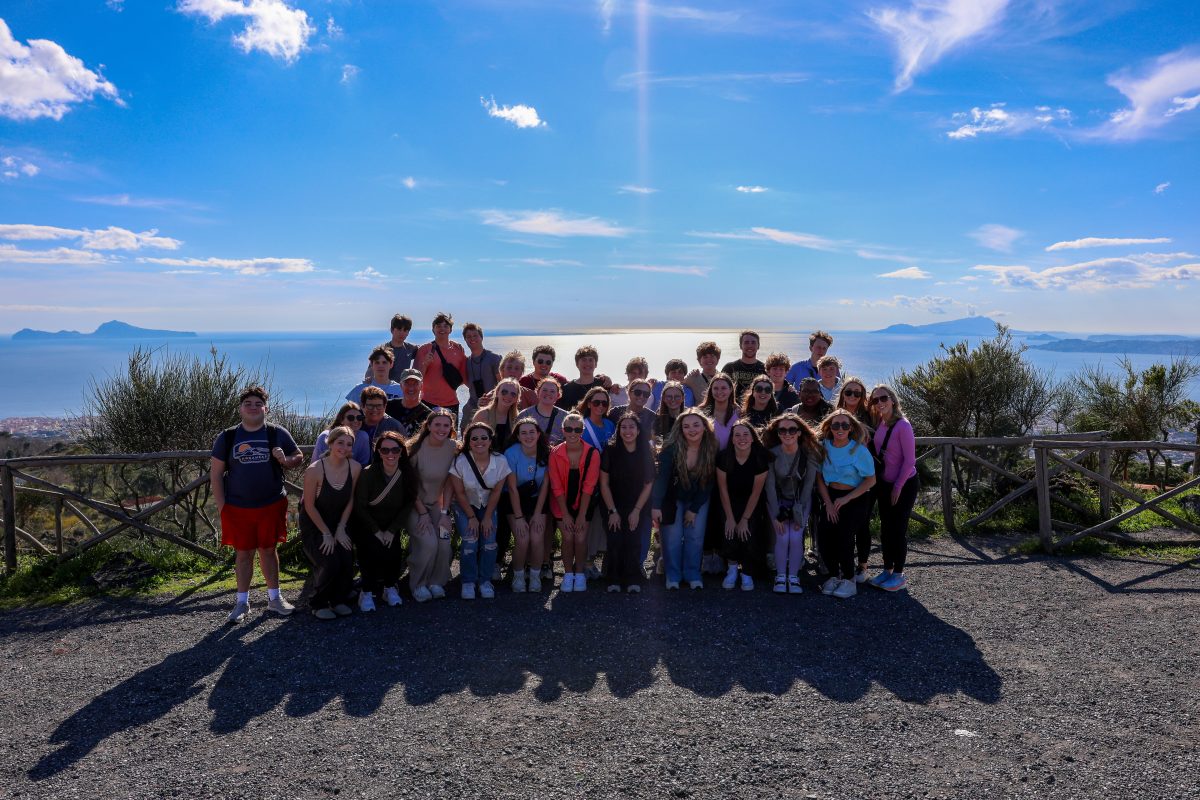
Three hours later we were back in the heart of Rome and headed for our dinner reservation. On the way, we got our first look at Rome’s most famous aquatic destination: The Trevi Fountain. No matter how many times you see it in books or movies, the site of the massive fountain and all of the people standing around staring at it absolutely takes your breath away. Our dinner was another round of pizza, but our first course was a strange, black salad that surprised us all as quite good. After dinner, we headed to the Spanish Steps for some nighttime pictures. It was, surprisingly, not very busy, and we took our time enjoying the view from the top of the stairs. From here, Niccolo said he had a surprise for us and wanted to show us one of the best views of the city. We climbed up and up and up until we reached a viewpoint near the top of the city that seemed to look out over the whole of Rome and Vatican City. Perfectly placed at this immaculate site was a busker with a small speaker and a microphone singing for tips. When we saw our group, he invited us to join him in a familiar Italian song and we all yelled out “That’s Amore!!” as our capitalizing entertainer sang one of Dean Martin’s signature tunes. But his next song really got the group moving as he began to sing ABBA’s “Dancing Queen” and a few senior boys started a conga line that everyone subsequently joined, even Niccolo! It certainly became one of the highlights of the trip. After an incredibly packed day, it felt nice to slip under the covers back at our hotel for some much needed Zzzzs.
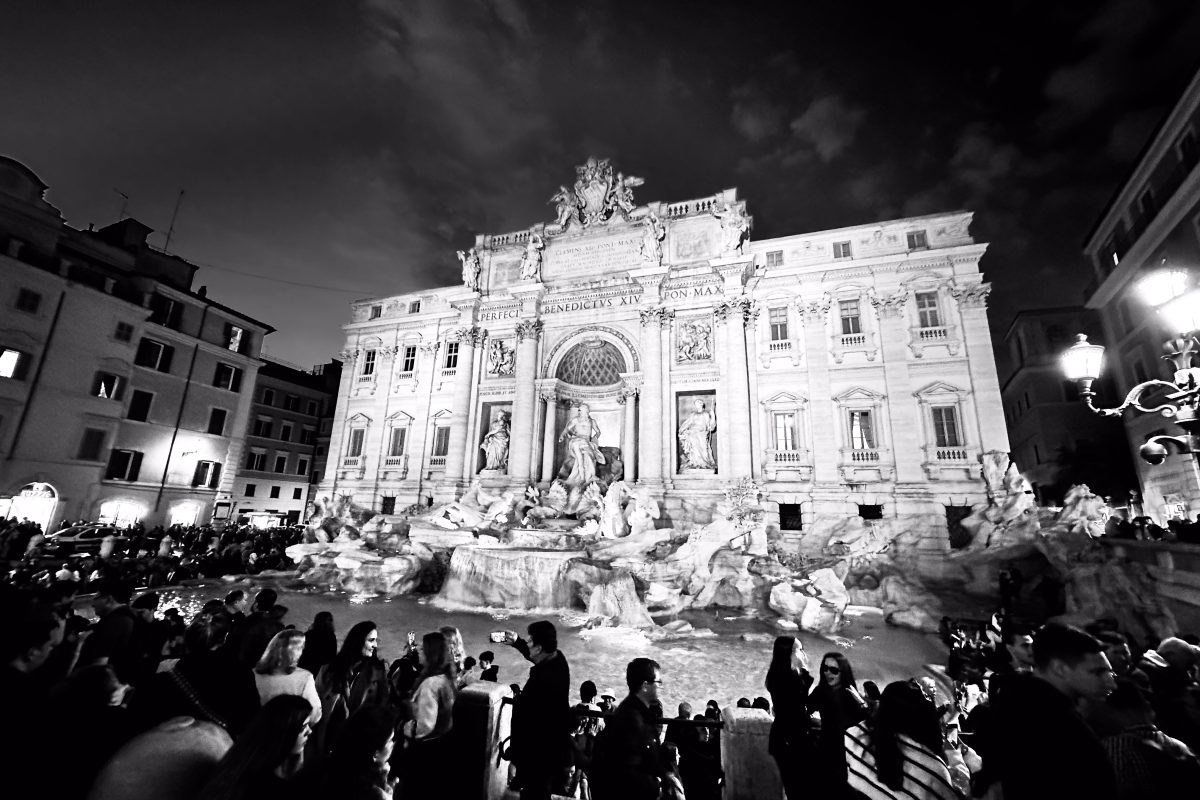
March 20
Our penultimate day in Rome began with a trip to the Basilica Papale di Santa Maria Maggiore, which is the second papal basilica we visited. Construction for the basilica began in the 5th century, and we were granted entry to the second floor balcony and a quick look at the famous Bernini hidden staircase, which is a spiral staircase said to have been built by Gian Lorenzo Bernini. The basilica was undeniably beautiful. Our guide showed us a door of the church that was only used by the pope but would be open to the public next year, as the Holy See prepares to celebrate the Jubilee. The signs of the approaching jubilee were visible everywhere, and it promises to bring millions of Catholic pilgrims to Rome.
Our next stop was a completely different country. We stepped into the world’s smallest country, Vatican City, as we stood and admired the view of St. Peter’s Basilica from St. Peter’s Square. It’s perhaps the most famous square in Italy, as it is the site where hundreds of thousands have gathered during important moments like the election of a new pope. We stood here for awhile, taking in the enormousness of the square and admiring the ancient Egyptian obelisk at the center of it. In the end, this was a close as we were to get to seeing the Vatican museums, as the line for entry grew by the second. Instead, we visited some souvenir sites and met our reservation for lunch just outside of St. Peter’s Square. Students enjoyed their choice of items for lunch. Many chose Roman specialties, such as pasta carbonara, while others were somehow able to order America’s own chicken strips for some reason.
Following lunch, we headed over to see the Roman granddaddy of all sites: the Colosseum. Though we knew what we were headed to see, we weren’t fully prepared as we turned through a bend in the road and the massive stadium towered before us. As we expected, the Colosseum grounds, which included the imposing Arch of Constantine, were swarming with people. We managed to get a few group pictures and then met up with our final guide. We went through security and passed through the same archways that caesars had used nearly 2000 years ago. Interestingly, the Colosseum was completed just one year after Mt. Vesuvius destroyed Pompeii. While the size and architectural extravagance of the Colosseum was top of mind, the enormity of what had taken place here was not lost on any of us. Over its nearly 300 years of use, the Colosseum is said to have played host to the death of somewhere between 400,000 to 1 million gladiators, criminals, political enemies, foreigners and of course, some Christians (though the number is debated). Just off of the main stage area of the arena stands a simple wooden cross. In fact, the Colosseum itself was designated a church by Pope Benedict XIV in the 18th century, in part to recognize the site as a place of Christian sacrifice. The “Christianization” of the Colosseum extends to the whole of Rome. Most of the ancient Roman sites at one point were rebranded and in many cases rebuilt as churches or holy sites. Nearly everywhere you look, you have a stark reminder that while certain leaders of Rome may have tried to snuff out the growing light of Christianity, eventually it consumed the city itself.
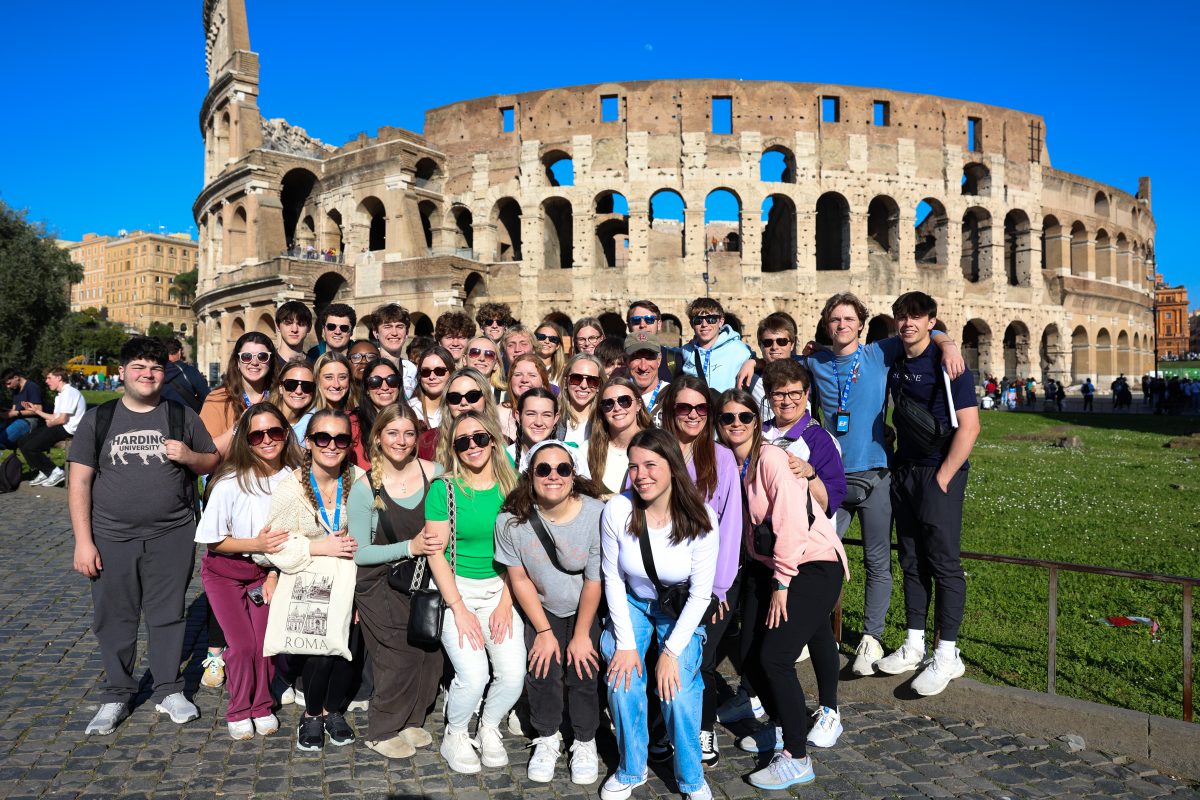
We left the Colosseum and walked across the grounds and up the Via Sacra to the ancient Roman Forum, which sits at the base of Capitoline Hill and features a number of historic buildings and ruins. Included among these is the house of Julius Caesar, the Temple of Saturn and the Arch of Titus, which commemorated the future Caesar’s victory over the Jews during the Jewish-Roman War in AD 71. Off in one of the corners of the Forum is the site where Marc Antony gave his speech on the death of Julius Caesar. The Forum is so drenched in historical significance, that it is hard to take it all in. Unfortunately, our time here was very brief, as the students were due for a restroom pitstop and the public toilets of the Forum had closed for the day.
So, off we headed for dinner and our final stop in Rome. We had a restaurant basement to ourselves where we enjoyed delicious focaccia bread for our first course and an incredible lasagna. During the meal, Jack Landes and Ella Tappe honored our beloved guide Niccolo and we all thanked him for his work and keeping his promise that the sun would follow him.
We had a couple hours of free time for the students to fan out with their buddies throughout the Eternal City to see what they had missed or wanted to revisit. Some made a beeline for souvenir shops, others enjoyed a coffee at the famous La Casa Del Caffe Tazza d’Oro, still others took a walk back through famous stops we had only paused at briefly. I wanted a better look at the immaculate Pantheon temple, which rises high above its crowded surroundings to serve as an absolute stunner of a sight. I also walked from there back to the Trevi Fountain, where I launched a few coins into the fountain. Tradition says that such an act will ensure you will return someday, and I certainly hope to do so.
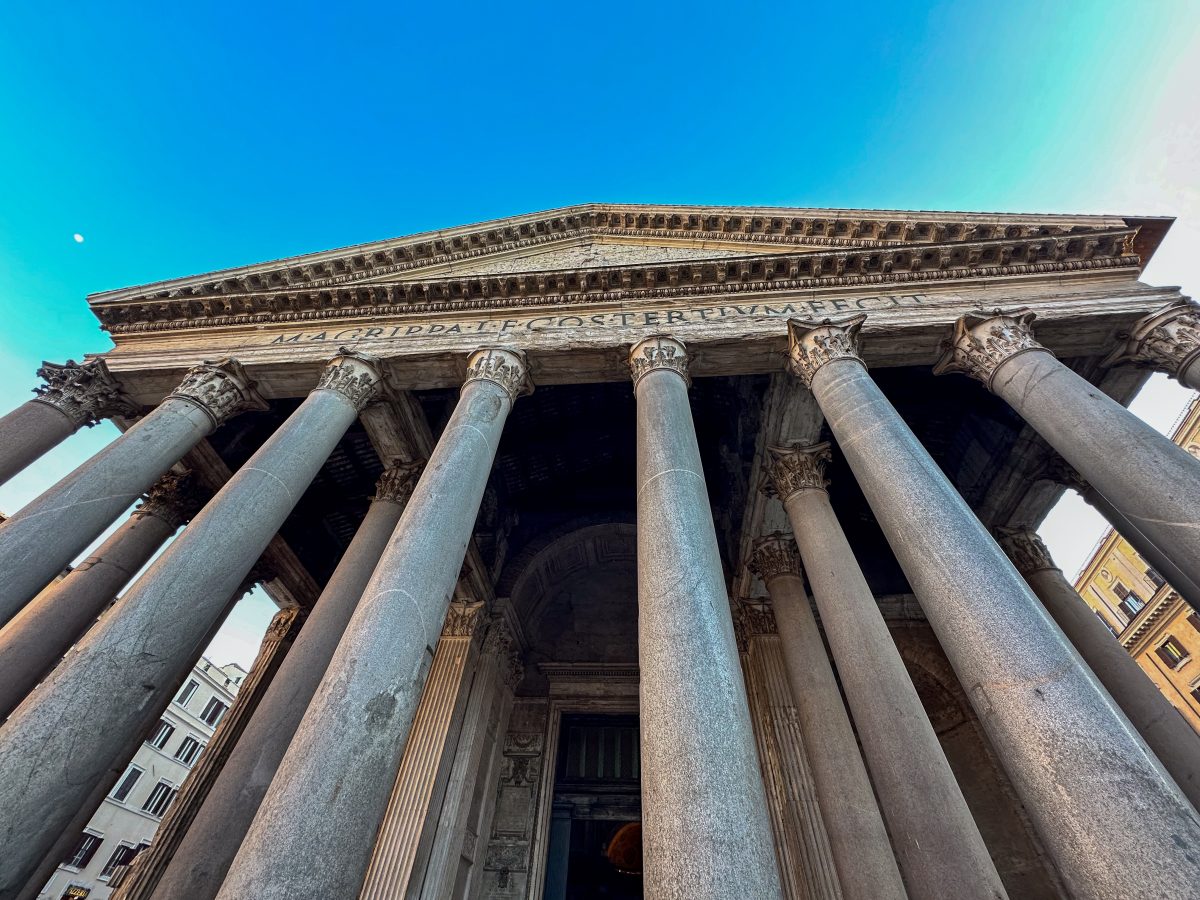
March 21
Home. After nearly a full day’s worth of flying, we finally make it home with no issues. Jack’s bag made it back to him just in time to fly home with him. Tori’s bag was a couple of weeks behind, but it eventually made it to Little Rock. Eventually, shouts of “Opa!” and “Grazie” faded away from our vocabulary. But the memories remain in full color. The smiles on seniors’ faces when I mention something from the trip are brilliant. A lifetime of memory in a span of eight days. And while few would probably say that they were changed, I know the truth. Among those of us who went on the trip, many have been imperceptibly placed on a path divergent from one they would have experienced without the aches and pains from days spent pounding the ancient streets of Athens and Rome. I cannot wait to see what mark they leave on the world. But I will stay patient and give them time; after all, Rome was not…well, you know.

